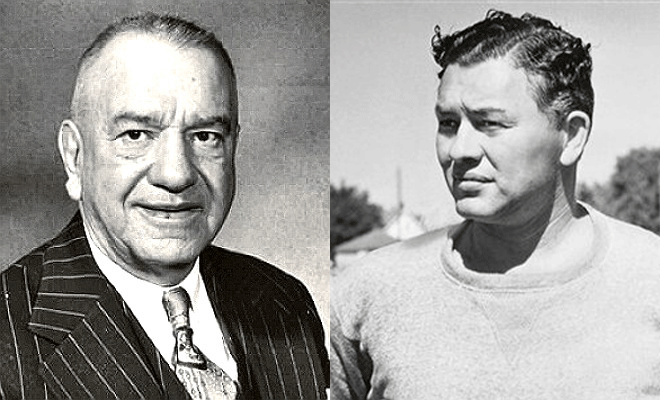Per Wikipedia, the tradition of football in Green Bay, Wisconsin goes back to 1896, earlier than any other NFL team. On the other hand, the Green Bay Packers organization recognizes 1919 as the first year of “competitive football” for the team, even though the Green Bay Packers were not affiliated with an association or a league. The “NFL” under a different name would not emerge until 1920.
In addition, when the Green Bay Packers sold common stock for the first time in 1923, they became the only team in the world to be publicly owned. Make no mistake; the Green Bay Packers history trail is deep and wide, and second to none.
According to sportsecyclopedia, Curly Lambeau played football under the tutelage of Knute Rockne at Notre Dame, but had to quit his freshmen year, due to a severe case of tonsillitis. Lambeau returned to Green Bay, where he played high school football and in the summer of 1919 he had a life changing conversation with George Calhoun, editor of the Green Bay Press-Gazette.
After talking to Calhoun and still wanting to play football, Curly Lambeau decided to organize his own team. In order to support Curly Lambeau’s goal, George Calhoun ran advertisements in the newspaper inviting prospective players to join the team.
In the meantime, Curly Lambeau arranged an agreement with his employer, the Indian Packing Company, because the team needed funds for uniforms and equipment. Lambeau also wanted to use a vacant lot owned by the company so that the team he was forming could practice. In exchange for $500 and a place to practice, Lambeau agreed to name the team the “Green Bay Indians.”
Once everything was in place, exactly 96 years ago to this day, on August 11, 1919 Curly Lambeau and George Calhoun met with local former high school football players in the editorial room at the Press-Gazette building and formed a football team. At this meeting Curly Lambeau was elected “captain” of the “Indians.”
Since the team was not affiliated with an association or a league, the Green Bay “Indians” in 1919 had to schedule their own games. That year the team posted a 10-1 winning record against other teams from Wisconsin and Michigan. They lost their last game to the Beloit “Fairies” by a score of 6-0. Besides the loss to the “Fairies,” the “Indians” allowed only one other team to score that year: The Racine “Iroquois.”
By the midway point of the 1919 season something changed. The Green Bay Press Gazette began referring to the team as the “Packers” and not the “Indians.” The nickname would stick and it was officially changed by the time the 1921 “NFL” season rolled around.
During the 1919 season the Green Bay “Packers” played 8 of their 11 games at home in Hagemeister Park, winning all 8 games. The “park” was a vacant lot next to Green Bay East High School. Since there were no bleachers until 1920, fans walked along the sidelines as the teams moved up and down the field during the game for free.
On the other hand, to offset the cost of player salaries, manager George Calhoun passed a hat around the crowd for donations and if you wanted to sit in the bleachers in 1920 you had to pay. At halftime, the teams would gather in their respective end zones to discuss and diagram in the dirt a second half game plan, because there were no locker rooms and chalkboards.
After the inaugural season, in an effort to further aid the development of a young organization, in 1923 the “Green Bay Packers” sold shares of common stock to the public. Shares have since been sold in 1935, 1950, 1997-98 and in 2011. The money generated from the first three sales kept the team in Green Bay and the last two sales helped pay for field and stadium renovations.
Interesting to note, people who bought Green Bay Packers common stock are “owners” but do not receive dividends or interest or for that matter season tickets. In fact if the team is sold, the money would not be divided up among the common stockholders; rather the profit would go to the Green Bay Packers Foundation, which is a foundation that currently assists many civic and educational programs.
One final note, per packers.com, on Aug. 27, 1921 the one year-old American Professional Football Association, formed in Canton, Ohio, awarded a franchise to Curly Lambeau and the “Acme Packers of Green Bay.” The Acme Packing Company, based in Chicago, had purchased the Indian Packing Company in Green Bay eight months earlier. Less than a year later, the American Professional Football Association would change its name to the National Football League. Green Bay was now in the “big leagues” and the rest is Green Bay Packers history.
Happy 96th Birthday, Green Bay Packers. GO-PACK- GO!
——————
Todd Stelzel, a loyal Packers fan since 1966, is a contributing writer with PackersTalk.com. You can follow him on Twitter at @ToddStelzel for more Packer news.
——————


3 responses to “The 1919 Green Bay Packers: The Start of Something Special”
If Curly hadn’t gotten tonsillitis, history would have ended up completely different. I wonder why a team would have named it’s team the “fairies”? Obviously, the connotation was different back then.
No kidding Peter…History would be completely different, “if Curly hadn’t gotten tonsillitis.” On the matter of the Beloit “Fairies”…the connotation was definitely different. The professional team was supported by Fairbanks Morse, a steam engine company from Beloit. Hence, the name “Fairies,” I believe. Another interesting note: Given the time period, seems like the GB Press Gazette was “PC” and ahead of the curve, when they began to call the “Indians” the “Packers” midway through the 1919 season.
We have the Cleveland Indians. If “Redskins” is offensive, maybe Washington ought to change its name to the Washington Indians.